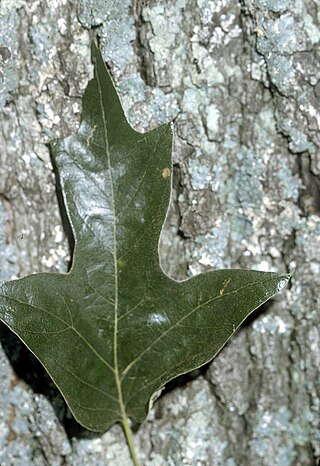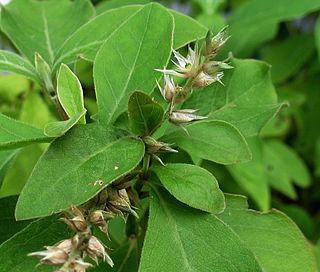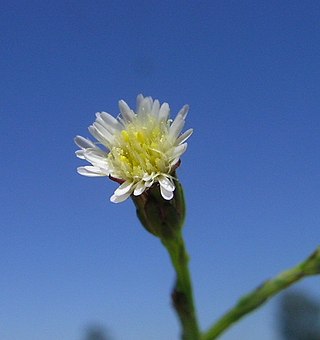
The nene, also known as the nēnē or the Hawaiian goose, is a species of bird endemic to the Hawaiian Islands. The nene is exclusively found in the wild on the islands of Oahu, Maui, Kauaʻi, Molokai, and Hawaiʻi. In 1957, it was designated as the official state bird of the state of Hawaiʻi.

Quercus falcata, also called southern red oak, spanish oak, bottomland red oak or three-lobed red oak is an oak. Native to the southeastern United States, it gets its name the "Spanish Oak" as these are the areas of early Spanish colonies, whilst "southern red oak" comes from both its range and leaf color during late summer and fall. The southern red oak is a deciduous angiosperm, so has leaves that die after each growing period and come back in the next period of growth.

Juniperus californica, the California juniper, is a species of juniper native to southwestern North America.

Anoectochilus, commonly known as marbled jewel orchids or filigree orchids, is a genus of about fifty species in the orchid family Orchidaceae. They are terrestrial herbs with a creeping rhizome, an upright flowering stem and dark coloured leaves with contrasting veins. The flowers are relatively large and have a large labellum, markedly different from the sepals and petals.

Charpentiera elliptica, the ellipticleaf pāpala, is an endangered species of flowering tree in the family Amaranthaceae, endemic to the island of Kauaʻi in Hawaiʻi. It inhabits coastal mesic and mixed mesic forests at elevations of 250–1,250 metres (820–4,100 ft). It is a perennial tree, growing up to 20 ft (6.1 m).

Prosopis glandulosa, commonly known as honey mesquite, is a species of small to medium-sized, thorny shrub or tree in the legume family (Fabaceae).

Dubautia microcephala, the small-head dubautia, is a species of flowering plant in the family Asteraceae. It is endemic to the island of Kauai in Hawaii. It is a perennial shrub or tree that grows up to 10 ft (3.0 m) tall.
The Lanai island-aster or Lanai hesperomannia is a species of flowering plant in the family Asteraceae.

Achyranthes mutica is a species of plant in the family Amaranthaceae. It is endemic to Hawaii. It is a perennial shrub that grows up to 2 ft (0.61 m) tall. Its natural habitats are dry forests and subtropical or tropical dry shrubland. It is threatened by habitat loss.

Alectryon macrococcus, known as ʻAlaʻalahua or Māhoe in Hawaiian, is a species of flowering tree in the soapberry family, Sapindaceae, that is endemic to Hawaii.
Melicope haleakalae, Haleakala melicope, is a species of plant in the family Rutaceae. It is endemic to the Hawaiian Islands. It is a perennial shrub or tree that grows up to 10 ft (3.0 m) tall. It grows in wet forests.

Iris virginica, with the common name Virginia blueflag, Virginia iris, great blue flag, or southern blue flag, is a perennial species of flowering plant in the Iridaceae (iris) family, native to central and eastern North America.
Clermontia drepanomorpha is a rare species of flowering plant in the bellflower family known by the common name Kohala Mountain clermontia. It is one of several Hawaiian lobelioids in genus Clermontia that are known as `oha wai. This plant is endemic to Kohala, a volcano at the northern end of the island of Hawaii. This is a federally listed endangered species of the United States. It is a perennial tree that can be terrestrial or epiphytic and it grows in wet boggy forests.
Cyanea copelandii is a rare species of flowering plant in the bellflower family known by the common name treetrunk cyanea. It is endemic to Maui, where there are no more than 250 individuals remaining in the wild. It is a federally listed endangered species of the United States. Like other Cyanea it is known as hāhā in Hawaiian.
Poa sandvicensis is a rare species of grass known by the common name Hawaiian bluegrass. It is endemic to Hawaii, where it is limited to the island of Kauai. It is threatened by the loss and modification of its habitat. It is a federally listed endangered species of the United States.
Govenia floridana, the Florida govenia, is an extinct species of orchid that was endemic to Everglades National Park in Florida. It was discovered for the first time in 1957, with a total populations of 25 individuals, and the last verified report was from the same site in 1964, where the population had declined to just 10 individuals. It is likely that poaching of plants contributed to its decline and extinction.

Symphyotrichum subulatum, commonly known as eastern annual saltmarsh aster or, in Britain and Ireland where it is naturalized, annual saltmarsh aster, is an annual plant in the family Asteraceae native to the eastern United States and the Gulf Coast to Texas. The species grows primarily in coastal salt marshes, although in the Ozarks it occurs as a non-marine weedy variety.

Epilobium coloratum, known by the common names purpleleaf willowherb and cinnamon willow-herb, is a species of flowering plant in the genus Epilobium of the willowherb family Onagraceae. This species is native to the Midwest and Eastern United States, as well as the Canadian provinces of Ontario, Québec, New Brunswick, Nova Scotia, and Newfoundland. It is also native to the Dominican Republic and Haiti.

Cyrtandra wawrae, the rockface cyrtandra, is a species of flowering plant in the family Gesneriaceae, native to Kauai, Hawaii. A shrub reaching 10 ft (3 m), it is often found growing on rock walls.













